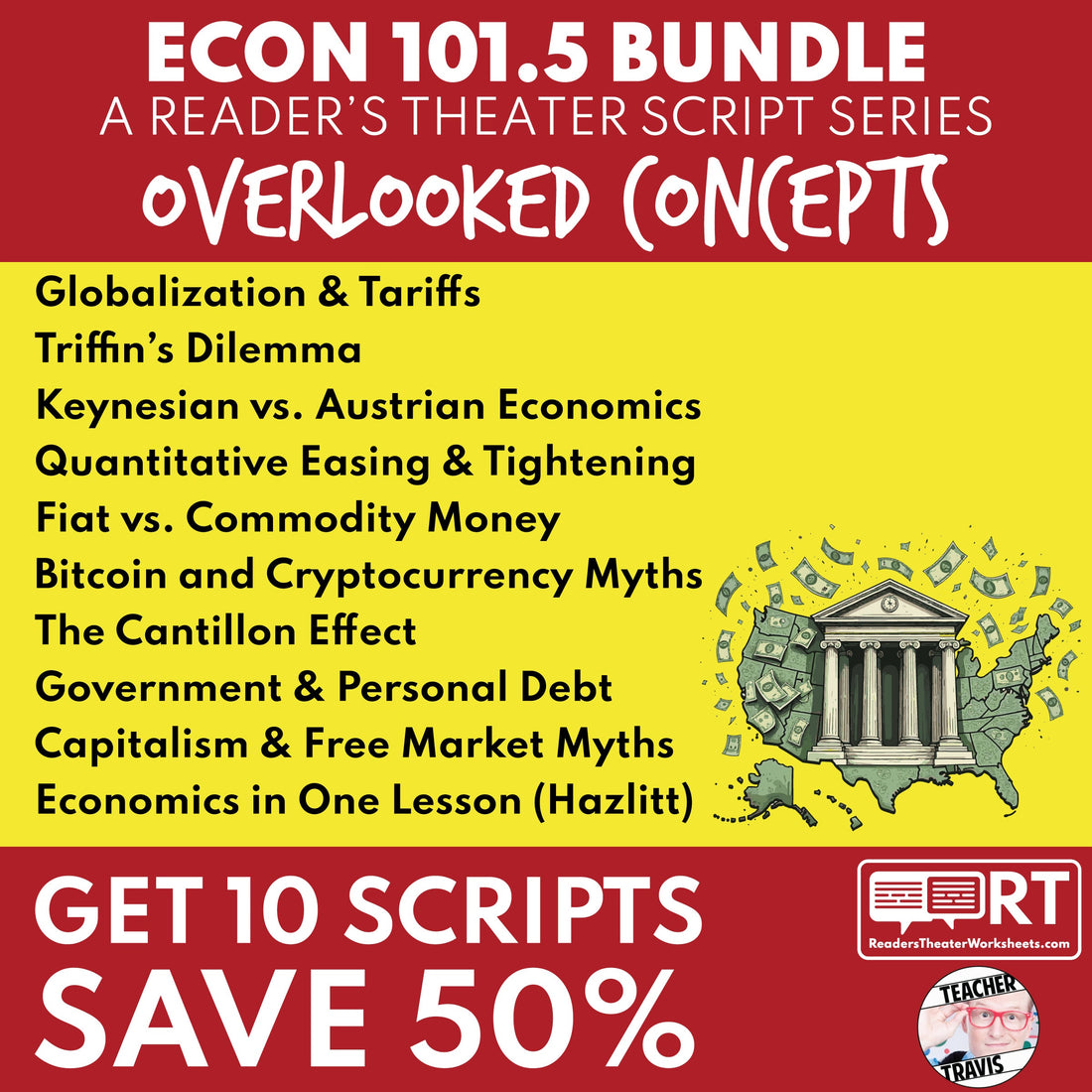
High School Economics Reader’s Theater: 10 Overlooked Austrian Concepts
Share
High School Economics Reader’s Theater: 10 Overlooked Austrian Concepts
High school economics curricula often stick to basics: supply and demand, scarcity, budgeting. But today’s teens want—and need—more. Concepts like Austrian economics, quantitative easing, Bitcoin myths, and Henry Hazlitt’s timeless insights rarely make it into textbooks, yet they directly shape the world students will inherit.
Why High School Economics Teachers Love Reader’s Theater
Instead of passive lectures, Reader’s Theater makes economics active and conversational. Students embody roles—debating as famous economists, skeptical teens, or informed critics. It’s perfect for AP Economics, homeschool co-ops, and traditional classrooms alike:
- Active Engagement: Students debate live, transforming abstract economic theories into relatable classroom conversations.
- Peer Learning: Role-playing economists and citizens, students reinforce understanding through dialogue and debate.
- Differentiated Learning: Scripts support varied reading and economic comprehension levels, ideal for diverse classrooms.
10 Interactive Economics Lesson Plans for Grades 9–12
This Economics 101.5 Bundle covers essential yet underrepresented concepts:
1. Globalization’s Winners & Losers and Tariffs
Students debate free trade’s complex reality, from affordable iPhones to lost factory jobs, guided by Adam Smith, Friedrich Hayek, Alexander Hamilton, and Thomas Sowell.
2. Triffin’s Dilemma
Explore the hidden cost of the U.S. dollar as the world's reserve currency, featuring Robert Triffin and Thomas Sowell, addressing global trade tensions and local economic impacts.
3. Keynesian vs. Austrian Economics
Students debate government spending versus free markets with historical economists John Maynard Keynes, Ludwig von Mises, Friedrich Hayek, and Paul Samuelson. Perfect for lessons on stimulus spending and economic policy.
4. Quantitative Easing (QE) & Quantitative Tightening (QT)
Clarify how central banks impact inflation and employment through monetary policy. Historical figures Ben Bernanke, Ludwig von Mises, and Friedrich Hayek guide students through the debates on QE’s boom and inflationary pitfalls.
5. Fiat vs. Commodity Money
Explore the history and risks of fiat currency versus gold-backed systems. Students are guided by economists Adam Smith, Murray Rothbard, Milton Friedman, and Ludwig von Mises, analyzing historical shifts and their modern consequences.
6. Bitcoin and Cryptocurrency Myths
This script debunks crypto misconceptions with experts Nic Carter, Jack Mallers, Jeff Booth, and critics like Peter Schiff. Students weigh Bitcoin's potential against its risks, perfect for discussions on digital finance.
7. The Cantillon Effect
Students uncover how newly created money enriches early recipients first, deepening economic inequalities. Featuring economists Saifedean Ammous, Lyn Alden, and critics Paul Krugman and Janet Yellen, students discuss inflation, savings, and wealth gaps.
8. Government & Personal Debt
With insights from experts Caitlin Long and Dave Ramsey, students investigate the rising tide of U.S. national debt and personal borrowing. This script highlights real-world implications of student loans and credit card debt.
9. Capitalism & Free Market Myths
Students debate capitalism’s true nature, addressing healthcare costs, Walmart’s low wages, and the pitfalls of socialism. Led by Mr. Patel, Ms. Kim, and student roles, this script fosters critical thinking on free markets and cronyism.
10. Economics in One Lesson (Based on Hazlitt)
Henry Hazlitt’s classic comes alive in a modern classroom scenario. Students led by Mr. Carter and Ms. Lopez explore hidden costs behind popular policies like rent control and minimum wage. Guest appearances by Hazlitt, Ludwig von Mises, Milton Friedman, and Thomas Sowell encourage deep, critical economic thinking.
What’s Included for Easy Classroom Integration:
- Google formats (which allows options to download to PPT, PDF, etc)
- Comprehension and discussion questions aligned to high school standards
- Flexible casting suitable for varied class sizes and abilities
Keywords High School Economics Teachers Use to Find this Resource:
- Austrian economics lessons for high school
- Henry Hazlitt Economics in One Lesson lesson plan
- Interactive economics lessons for grades 9–12
- High school curriculum on Bitcoin and cryptocurrency
- Classroom activities on inflation and monetary policy
- Economics scripts for classroom debate
FAQs for High School Economics Teachers:
Are these scripts suitable for AP Economics courses? Yes, especially scripts like Keynesian vs. Austrian Economics and Economics in One Lesson, ideal for advanced discussions.
Do these lessons align with Common Core or state standards? Yes, each script includes comprehension and vocabulary activities designed specifically to align with high school economics standards.
Transform Your Economics Classroom Today!
From Austrian economic principles to Bitcoin myths, the Economics 101.5 Reader’s Theater Scripts Bundle helps students actively engage with essential economic ideas shaping their world.
Download the bundle now and revolutionize your high school economics curriculum!
